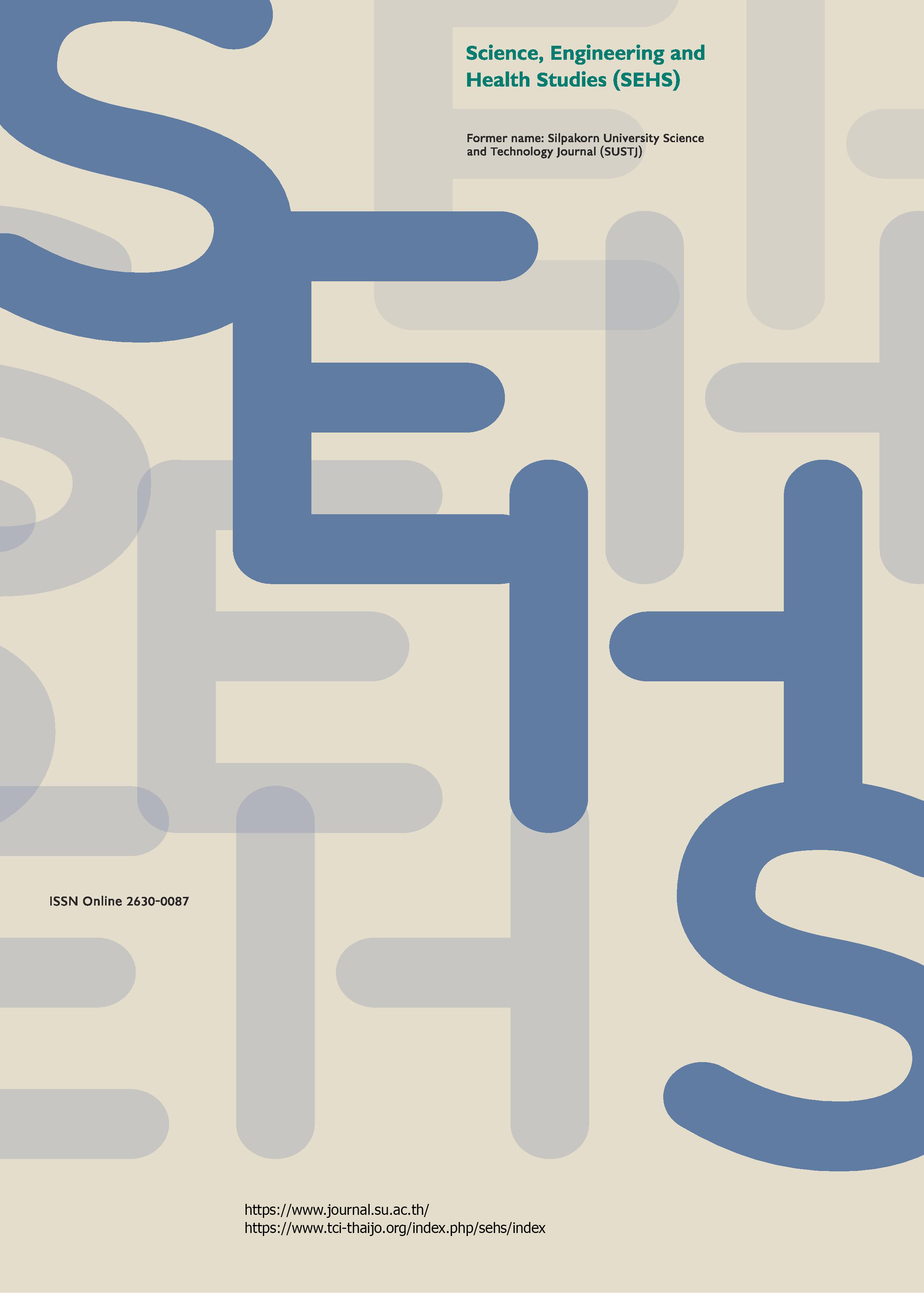Two-stage stochastic optimization of sustainable bioethanol supply chain based on demand uncertainty and seasonal availability of biomass
Main Article Content
Abstract
Bioethanol-blended gasoline fuel is one of the alternatives for reducing CO2 emissions in the transportation sector. Since its production is still dependent on demand fluctuations and feedstock availability, an optimal supply chain design needs to be evaluated. A two-stage stochastic optimization model with mixed-integer linear programming (MILP) was developed for designing the optimal bioethanol supply chain under the constraints of multi-feedstock second-generation biomass based on seasonal availability and demand uncertainty. Two optimization models were implemented. The goal of the first model was to maximize the expected profits of the supply chain based on the optimal combination of biomass type, plant location and biomass-bioethanol pathways. The second extension model focused on maximizing expected profits of the supply chain with the least amount of impact on the environment via the reduction of net emission to result in an optimal supply chain. The validation process was then performed by comparing the stochastic and deterministic models in terms of plant location and operating decisions. The first model was applied to actual data of a Thailand case study involving 26 existing plants and agricultural residue availability. The optimization result illustrates that the stochastic model is 16% more profitable than the deterministic model for all random data sets. Furthermore, the extension model shows that carbon credit can contribute to around 5% of the total profit earned. Thus, the proposed models can address demand uncertainty in supply chain design and can be implemented by policymakers to achieve sustainable bioethanol production.
Downloads
Article Details

This work is licensed under a Creative Commons Attribution-NonCommercial-NoDerivatives 4.0 International License.
References
Anggono, J., Purwaningsih, H., Sugondo, S., Henrico, S., Sewucipto, S., Patel, J. (2019). Structural evaluation on sugarcane bagasse treated using sodium and calcium hydroxide. E3S Web of Conferences, 130, 01018.
Awudu, I., and Zhang, J. (2013). Stochastic production planning for a biofuel supply chain under demand and price uncertainties. Applied Energy, 103, 189–196.
Azadeh, A., Vafa Arani, H., and Dashti, H. (2014). A stochastic programming approach towards optimization of biofuel supply chain. Energy, 76, 513–525.
Bakker, H., Dunke, F., and Nickel, S. (2020). A structuring review on multi-stage optimization under uncertainty: Aligning concepts from theory and practice. Omega, 96, 102080.
BloombergNEF. (2022). Thailand. Climatescope [Online URL: https://www.global-climatescope.org/markets/thailand] accessed on October 16, 2023.
GlobalPetrolPrices. (2023). Thailand ethanol prices. GlobalPetrolPrices. [Online URL: https://www.globalpetrolprices.com/Thailand/ethanol_prices/] accessed on November 20, 2023.
Huang, X., Ji, L., Yin, J., and Huang, G. (2024). Optimal design and robust operational management of regional bioethanol supply chain with various technological choices and uncertainty fusions. Computers and Chemical Engineering, 182, 108565.
International Energy Agency (IEA). (2023). Tracking Clean Energy Process 2023. IEA. [Online URL: https://www.iea.org/reports/tracking-clean-energy-progress-2023] accessed on August 17, 2023.
Ishii, K., Furuichi, T., Fujiyama, A., and Watanabe, S. (2016). Logistics cost analysis of rice straw pellets for feasible production capacity and spatial scale in heat utilization systems: A case study in Nanporo town, Hokkaido, Japan. Biomass and Bioenergy, 94, 155–166.
Jusakulvijit, P., Bezama, A., and Thrän, D. (2021). The availability and assessment of potential agricultural residues for the regional development of second-generation bioethanol in Thailand. Waste and Biomass Valorization, 12(11), 6091–6118.
Kawasaki, J., Silalertruksa, T., Scheyvens, H., and Yamanoshita, M. (2015). Environmental sustainability and climate benefits of green technology for bioethanol production in Thailand. The International Society for Southeast Asian Agricultural Sciences, 21(1), 78–95.
Kent, G. (2007). The value of bagasse to an Australian raw sugar factory. In Proceedings of the 2007 Conference of the Australian Society of Sugar Cane Technologists (Bruce, R. C., Ed.), pp. 453–459. Queensland, Australia.
Khanunthong, A. (2021). Thailand Industry Outlook 2021-2023: Ethanol Industry. [Online URL: https://www.krungsri.com/getmedia/61c06e98-467c-41f1-ab54-24f9746a8524/IO_Ethanol_211014_EN_EX.pdf.aspx] accessed on September 3, 2023.
Kwon, O., and Han, J. (2021). Supply chain management of butyric acid-derived butanol: Stochastic approach. Applied Energy, 297, 117119.
Li, X., Lu, S., Li, Z., Wang, Y., and Zhu, L. (2022). Modeling and optimization of bioethanol production planning under hybrid uncertainty: A heuristic multi-stage stochastic programming approach. Energy, 245, 123285.
Lima, C., Batista, M., Relvas, S., and Barbosa-Póvoa, A. (2023). Optimizing the design and planning of a sugar-bioethanol supply chain under uncertain market conditions. Industrial & Engineering Chemistry Research, 62(15), 6224–6240.
Muryanto, Triwahyuni, E., Abimayu, H., Cahyono, A., Cahyono, E. T., and Sudiyani, Y. (2015). Alkaline delignification of oil palm empty fruit bunch using black liquor from pretreatment. Procedia Chemistry, 16, 99–105.
Osmani, A., and Zhang, J. (2014). Economic and environmental optimization of a large scale sustainable dual feedstock lignocellulosic-based bioethanol supply chain in a stochastic environment. Applied Energy, 114, 572–587.
Palniandy, L. K., Wong, W. Y., Yap, J. J., Doshi, V., and Yoon, L. W. (2017). Effect of alkaline pre-treatment on rice husk-derived biochar for direct carbon fuel cell. Journal of Engineering Science and Technology, 12(Special), 84–100.
Polprasert, S., Choopakar, O., and Elefsiniotis, P. (2021). Bioethanol production from pretreated palm empty fruit bunch (PEFB) using sequential enzymatic hydrolysis and yeast fermentation. Biomass and Bioenergy, 149, 106088.
Sombatpraiwan, S., Junyusen, T., Treeamnuk, T., and Junyusen, P. (2019). Optimization of microwave‐assisted alkali pretreatment of cassava rhizome for enhanced enzymatic hydrolysis glucose yield. Food and Energy Security, 8(4), e00174.
Suchartsunthorn, N., and Siemanond, K. (2017). Two-stage stochastic optimization of carbon dioxide supply chain and utilization model through carbon dioxide capturing process. Computer Aided Chemical Engineering, 40, 727–732.
Wang, M., Wu, M., and Huo, H. (2007). Life-cycle energy and greenhouse gas emission impacts of different corn ethanol plant types. Environmental Research Letters, 2, 024001.
Yu, J., Lee, I.-B., Han, J., and Ahn, Y. (2020). Stochastic approach to optimize the supply chain network of microalga-derived biodiesel under uncertain diesel demand. Journal of Chemical Engineering of Japan, 53(1), 24–35.
Zarei, M., Shams, M. H., Niaz, H., Won, W., Lee, C.-J., and Liu, J. J. (2022). Risk-based multistage stochastic mixed-integer optimization for biofuel supply chain management under multiple uncertainties. Renewable Energy, 200, 694–705.

